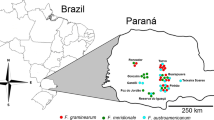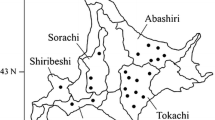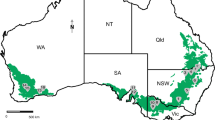Abstract
Fusarium poae is one of the Fusarium species isolated from cereal grains infected by Fusarium head blight (FHB), and in recent years it has been identified as a major FHB component. In this study, 97 F. poae isolates from Argentina (n = 62) and England (n = 35) were analysed by inter-simple sequence repeats (ISSR) to examine the genetic diversity and to determine whether intraspecific variation could be correlated with geographic and/or host origin. The molecular analysis showed high intraspecific variability within F. poae isolates, but did not reveal a clear relationship between variability and the host/geographic origin. Fusarium poae isolates from the same geographic region or host appeared in different subclusters. Conversely, isolates with the same haplotype were also collected from different geographic regions. However, we did observe subclusters consisting of isolates from Argentina only or from England only. Furthermore, a single seed sample was found to host different haplotypes. Analysis of molecular variance (AMOVA) indicated a high genetic variability in F. poae, with most of the genetic variability explained by differences within, rather than between Argentinean and English populations. This is the first report on genetic diversity of F. poae using ISSR markers. Moreover, ISSR fingerprinting generates highly polymorphic markers for F. poae and proved to be a useful and reliable assay for genetic variability studies.


Similar content being viewed by others
References
Bayraktar, H., Dolar, F. S., & Maden, S. (2007). Use of RAPD and ISSR markers in detection of genetic variation and population structure among Fusarium oxysporum f. sp. ciceris isolates on chickpea in Turkey. Journal of Phytopathology, 156, 146–154.
Birzele, B., Meier, A., Hindorf, H., Kramer, J., & Dehne, H. W. (2002). Epidemiology of Fusarium infection and deoxynivalenol content in winter wheat in the Rhineland, Germany. European Journal of Plant Pathology, 108, 667–673.
Bornet, B., & Branchard, M. (2001). Nonanchored inter sequence repeat (ISSR) markers: reproducible and specific tools for genome fingerprinting. Plant Molecular Biology Reporter, 19, 209–215.
Bourdages, J. V., Marchand, S., Rioux, S., & Belzile, F. J. (2006). Diversity and prevalence of Fusarium species from Quebec barley fields. Canadian Journal of Plant Pathology, 28, 419–425.
Chelkowski, J., Ritieni, A., Wisniewska, H., Mulé, G., & Logrieco, A. (2007). Occurrence of toxic hexadepsipeptides in preharvest maize ear rot infected by Fusarium poae in Poland. Journal of Phytopathology, 155, 8–12.
Desjardins, A. E. (2006). Fusarium mycotoxins. Chemistry, genetics, and biology. St. Paul: APS Press. 260 pp.
Excoffier, L., Smouse, P. E., & Quattro, J. M. (1992). Analysis of molecular variance inferred from metric distances among DNA haplotypes: application to human mitochondrial DNA restriction data. Genetics, 131, 479–491.
Gargouri, S., Bernier, L., Hajlaoui, M. R., & Marrakchi, M. (2003). Genetic variability and population structure of the wheat foot rot fungus, Fusarium culmorum, in Tunisia. European Journal of Plant Pathology, 109, 807–815.
Jestoi, M., Rokka, M., Yli-Mattila, T., Parikkas, P., Rizzo, A., & Peltonen, K. (2004). Presence and concentration of the Fusarium-related mycotoxins beauvericin, enniatins and moniliformin in Finnish grain samples. Food Additives and Contaminants, 21, 794–802.
Jestoi, M., Paavanen-Huhtala, S., Parikka, P., & Yli-Mattila, T. (2008). In vitro and in vivo mycotoxin production of Fusarium species isolated from Finnish grains. Archives of Phytopathology and Plant Protection, 41, 545–558.
Kerényi, Z., Táborhegyi, E., Pomázi, A., & Hornok, L. (1997). Variability amongst strains of Fusarium poae assessed by vegetative compatibility and RAPD polymorphism. Plant Pathology, 46, 882–889.
Kerényi, Z., Moretti, A., Waalwijk, C., Oláh, B., & Hornok, L. (2004). Mating type sequences in asexually reproducing Fusarium species. Applied and Environmental Microbiology, 70, 4419–4423.
Kistler, H. C., & Miao, V. P. M. (1992). New models of genetic change in filamentous fungi. Annual Review Phytopathology, 30, 131–152.
Kulik, T., & Jestoi, M. (2009). Quantification of Fusarium poae DNA and associated mycotoxins in asymptomatically contaminated wheat. International Journal of Food Microbiology, 130, 233–237.
Langseth, W., Bernhoft, A., Rundberget, T., Kosiak, B., & Gareis, M. (1999). Mycotoxin production and cytoxicity of Fusarium strains isolated from Norwegian cereals. Mycopathologia, 144, 103–113.
Leslie, J. F., & Summerell, B. A. (2006). The Fusarium laboratory manual. Iowa: Blackwell. 388 pp.
Miedaner, T., Schilling, A. G., & Geiger, H. H. (2001). Molecular genetic diversity and variation for aggressiveness in populations of Fusarium graminearum and Fusarium culmorum sampled from wheat fields in different countries. Journal of Phytopathology, 149, 641–648.
Mishra, P. K., Fox, R. T. V., & Culham, A. (2003). Inter-simple sequence repeat and aggressiveness analyses revealed high genetic diversity, recombination and long range dispersal in Fusarium culmorum. Annals of Applied Biology, 143, 291–301.
Mishra, P. K., Tewari, J. P., Clear, R. M., & Turkington, T. K. (2004). Molecular genetic variation and geographical structuring in Fusarium graminearum. Annals of Applied Biology, 145, 299–307.
Nei, M. (1987). Molecular evolutionary genetics. New York: Columbia University Press. 512 pp.
Ouellet, T., & Seifert, K. A. (1993). Genetic characterization of Fusarium graminearum strains using RAPD and PCR amplification. Phytopathology, 83, 1003–1007.
Parry, D. W., & Nicholson, P. (1996). Development of a PCR assay to detect Fusarium poae in wheat. Plant Pathology, 45, 383–391.
Qu, B., Li, H. P., Zhang, J. B., Xu, Y. B., Huang, T., Wu, A. B., et al. (2008). Geographic distribution and genetic diversity of Fusarium graminearum and F. asiaticum on wheat spikes throughout China. Plant Pathology, 57, 15–24.
Rohlf, F. I. (1998). NTSYSpc. Numerical taxonomy and multivariate analysis system Version 2.0. Applied Biostatistics. New York: Exeter Software.
Schmidt, H., Niessen, L., & Vogel, R. (2004). AFLP analysis of Fusarium species in the section Sporotrichiella-evidence for Fusarium langsethiae as a new species. International Journal of Food Microbiology, 95, 297–304.
Schneider, S., Roessli, D., & Excoffier, L. (2000). Arlequin. Version 2.0: a software for populations genetic data analysis. Switzerland: University of Geneva.
Sneath, P. H., & Sokal, R. R. (1973). Numerical taxonomy. San Francisco: Freeman. 573 pp.
Stenglein, S. A. (2009). Fusarium poae: a pathogen that needs more attention. Journal of Plant Pathology, 91, 25–36.
Stenglein, S. A., & Balatti, P. A. (2006). Genetic diversity of Phaeoisariopsis griseola in Argentina as revealed by pathogenic and molecular markers. Physiological and Molecular Plant Pathology, 68, 158–167.
Stenglein, S. A., Dinolfo, M. I., Moreno, M. V., Rogers, W. J., & Salerno, G. L. (2008). Avances en el estudio de la ocurrencia de Fusarium poae en la Argentina. In H. Mirassón, M. L. Faraldo & E. M. Baudino (Eds.), Proceedings of the VII Congreso Nacional de Trigo, V Simposio Nacional de Cereales de Siembra Otoño-Invernal, I Encuentro del MERCOSUR (PV17). Mar del Plata, Argentina.
Stenglein, S. A., Barreto, D., Nicholson, P., Chandler, E., Brambilla, V., Piris, E. M., et al. (2009). First report of Fusarium poae on tomato in Argentina. Plant Pathology, 58, 401–401.
Stenglein, S. A., Rodriguero, M. S., Chandler, E., Jennings, P., Salerno, G., & Nicholson, P. (2010). Phylogenetic relationships of Fusarium poae based on EF-1α and mtSSU sequences. Fungal Biology, 114, 96–1061.
Thrane, U., Adler, A., Clasen, P., Galvano, F., Langseth, W., Lew, H., et al. (2004). Diversity in metabolite production by Fusarium langsethiae, Fusarium poae, and Fusarium sporotrichioides. International Journal of Food Microbiology, 95, 257–266.
Vogelgsang, S., Sulyok, M., Bänziger, I., Krska, R., Schuhmacher, R., & Forrer, H. R. (2008a). Effect of fungal strain and cereal substrate on in vitro mycotoxin production by Fusarium poae and Fusarium avenaceum. Food Additives and Contaminants, 25, 745–757.
Vogelgsang, S., Sulyok, M., Hecker, A., Jenny, E., Krska, R., Schuhmacher, R., et al. (2008b). Toxigenicity and pathogenicity of Fusarium poae and Fusarium avenaceum on wheat. European Journal of Plant Pathology, 122, 265–276.
Vogelgsang, S., Widmer, F., Jenny, E., & Enkerli, J. (2009). Characterisation of novel Fusarium graminearum microsatellite markers in different Fusarium species from various countries. European Journal of Plant Pathology, 123, 477–482.
Wong, L. S. L., Tekauz, A., Leisle, D., Abramson, D., & McKenzie, R. I. H. (1992). Prevalence, distribution, and importance of Fusarium head blight in wheat in Manitoba. Canadian Journal of Plant Pathology, 14, 233–238.
Xu, X., Parry, D., Nicholson, P., Thomsett, M., Simpson, D., Edwards, S., et al. (2005). Predominance and association of pathogenic fungi causing Fusarium ear blight in wheat in four European countries. European Journal of Plant Pathology, 112, 143–154.
Xu, X., Monger, W., Ritieni, A., & Nicholson, P. (2007). Effect of temperature and duration of wetness during initial infection periods on disease development, fungal biomass and mycotoxin concentrations on wheat inoculated with single, or combinations of, Fusarium species. Plant Pathology, 56, 943–956.
Yap, I. V., & Nelson, R. J. (1996). WINBOOT: a program for performing bootstrap analysis of binary data to determine the confidence limits of UPGMA-based dendrograms. IRRI discussion paper series No. 14, International Rice Research Institute: Manila, Philippines.
Yli-Mattila, T., Mach, R. L., Alekhina, I. A., Bulat, S. A., Koskinen, S., Kullnig-Gradinger, C. M., et al. (2004). Phylogenetic relationship of Fusarium langsethiae to Fusarium poae and Fusarium sporotrichioides as inferred by IGS, ITS, β-tubulin sequences and UP-PCR hybridization analysis. International Journal of Food Microbiology, 95, 267–285.
Yli-Mattila, T., Paavanen-Huhtala, S., Jestoi, M., Parikka, P., Hietaniemi, V., Gagkaeva, T., et al. (2008). Real-time PCR detection and quantification of Fusarium poae, F. graminearum, F. sporotrichioides and F. langsethiae in cereal grains in Finland and Russia. Archives of Phytopathology and Plant Protection, 41, 243–260.
Zeigler, R. S., Scott, R. P., Leung, H., Bordeos, A. A., Kumar, J., & Nelson, R. J. (1997). Evidence of parasexual exchange of DNA in the rice blast fungus challenges its exclusive clonality. Phytopathology, 87, 284–294.
Zietkiewicz, E., Raflaski, A., & Labuda, D. (1994). Genome fingerprinting by simple sequence repeat (SSR)-anchores polymerase chain reaction amplification. Genomics, 20, 176–183.
Acknowledgements
This work was supported by FONCYT-SECYT PICT-PRH 2008/110, CONICET and UNCPBA.
Author information
Authors and Affiliations
Corresponding author
Rights and permissions
About this article
Cite this article
Dinolfo, M.I., Stenglein, S.A., Moreno, M.V. et al. ISSR markers detect high genetic variation among Fusarium poae isolates from Argentina and England. Eur J Plant Pathol 127, 483–491 (2010). https://doi.org/10.1007/s10658-010-9613-1
Accepted:
Published:
Issue Date:
DOI: https://doi.org/10.1007/s10658-010-9613-1




